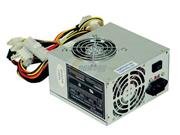Power To The People - and their PCs
(September, 2007)
 It’s
been said that if the brain of your computer is the CPU chip, then the heart is
the power supply unit (PSU). But along with hard drives, the PSU is the most
failure prone component in your PC. It is subject to heating and cooling with
each cycling on and off of your machine, and it absorbs the initial surge of AC
power from the wall plug when powered on. It is not necessary for a computer
user to be intimately familiar with their power supply, but there is value in
understanding the role it plays and being aware of the symptoms of a failing or
unstable unit. Many system lock-ups and unintended reboots result from a power
supply in need of replacement.
It’s
been said that if the brain of your computer is the CPU chip, then the heart is
the power supply unit (PSU). But along with hard drives, the PSU is the most
failure prone component in your PC. It is subject to heating and cooling with
each cycling on and off of your machine, and it absorbs the initial surge of AC
power from the wall plug when powered on. It is not necessary for a computer
user to be intimately familiar with their power supply, but there is value in
understanding the role it plays and being aware of the symptoms of a failing or
unstable unit. Many system lock-ups and unintended reboots result from a power
supply in need of replacement.
The purpose of the power supply is to take the 115 volts of AC power that your
wall outlet dishes out, and convert it to low voltage direct current required to
power the electronic components that make up your PC. A transformer system in
the power supply steps down the 115 volts to each of three low voltages: 3.3
volts for the memory modules and CPU chip; 5 volts to run the motherboard; and
12 volts to power the drives (hard drives, CD and DVD units, and some system
fans.)
In a tower style computer, the power supply is usually located in the upper rear
of the machine. When you plug in your power cord, you are in fact plugging it
into the power supply, which is a small metal box that lives inside the big
metal box. The power from the PSU is carried to the other components via a
series of thin cables that terminate in many different types of standardized
plugs. The main connector consists of either 20 or 24 wires that plug into the
system’s main circuit board (the ‘motherboard’). A small square 4-wire
connector, the so-called P4 connector, may also plug into the motherboard to
deliver auxiliary power to the CPU. A different type of D-shaped connector,
called a Molex connector (named after one of the major supplying companies),
carries four wires and plugs into hard drives and optical drives, as well as
certain auxiliary cooling fans. A small flat connector carries power to the
floppy drive, while a 6-pin connector is used on newer motherboards to provide
added power to PCI-Express video cards. Finally, keyed black connectors are
used to power serial ATA (SATA) drive units. Wires are color coded. In
general, black designates ground wires, yellow indicates 12V wires, and red
signifies 5V wires, but that convention is not hard and fast.
Power supply prices vary greatly. Your basic low-end unit, typical in most low
price-point computers, will sell for around $30. At the high end, my favorite
on-line purveyor of computer components, NewEg.com, sells four units ranging
from $390 to $460. Most people expect a whole computer for that price. A wide
range of solid offerings exist between $50 and $120. What do you get for the
extra cash outlay?
Low-end units will have maximum power outputs of between 200 and 350 watts. The
ultra-expensive units mentioned above are capable of putting out up to 1,300
watts. (Most well-configured machines get by comfortably on 450 watts.) You
can replace a 250 watt unit with a 450 watt unit without damaging anything. The
system will only draw what it requires to run the components. The added wattage
capability just provides a wider margin of safety and stability. However, when
replacing a power supply, you need to make sure the replacement will physically
fit in the case. Many smaller HP PCs require an extra short power supply in
order to make the tight fit – 4” deep rather than the typical 6” deep.
Wattage alone does not provide insight into overall quality. A better PSU will
provide 2 or more 12V “rails”, for more even power distribution to the drives.
A low-end unit will typically deliver its 12 volts down one rail. Better units
will employ active Power Factor Correction to insure against voltage drops when
the system is under load, as when a drive spins up. Low end machines use
passive PFC, or none at all. Tight regulation is critical for devices that use
low voltage digital logic, as significant fluctuations can result in data
errors. Better PSUs also will trumpet their higher efficiency. The upper end
units will convert 80% or more of their input power to output power. The
balance is lost as heat, and heat is one of a computer’s greatest enemies.
 One of the
newer developments in PC power supplies is the introduction of ‘modular’ units.
Instead of coming bundled with a handful of fixed wires and connectors which are
likely more than you need and end up getting tucked out of the way to try and
reduce any barriers to air flow, modular units provide their cables as plug-in
wires which can be added as needed, making for a cleaner installation allowing
for better air movement. More attention is also being paid to the cooling fans
used to remove heat from the PSUs, in order to make the units as silent as
possible. With computers migrating to the core of home media delivery systems,
quiet is becoming a must.
One of the
newer developments in PC power supplies is the introduction of ‘modular’ units.
Instead of coming bundled with a handful of fixed wires and connectors which are
likely more than you need and end up getting tucked out of the way to try and
reduce any barriers to air flow, modular units provide their cables as plug-in
wires which can be added as needed, making for a cleaner installation allowing
for better air movement. More attention is also being paid to the cooling fans
used to remove heat from the PSUs, in order to make the units as silent as
possible. With computers migrating to the core of home media delivery systems,
quiet is becoming a must.
There are several excellent brands of PSUs, notably Antec, EnerMax, PC Power &
Cooling, and ThermalTake. You’ll pay more for these brands, but you’ll reduce
your chance of system failure due to power issues.
 It’s
been said that if the brain of your computer is the CPU chip, then the heart is
the power supply unit (PSU). But along with hard drives, the PSU is the most
failure prone component in your PC. It is subject to heating and cooling with
each cycling on and off of your machine, and it absorbs the initial surge of AC
power from the wall plug when powered on. It is not necessary for a computer
user to be intimately familiar with their power supply, but there is value in
understanding the role it plays and being aware of the symptoms of a failing or
unstable unit. Many system lock-ups and unintended reboots result from a power
supply in need of replacement.
It’s
been said that if the brain of your computer is the CPU chip, then the heart is
the power supply unit (PSU). But along with hard drives, the PSU is the most
failure prone component in your PC. It is subject to heating and cooling with
each cycling on and off of your machine, and it absorbs the initial surge of AC
power from the wall plug when powered on. It is not necessary for a computer
user to be intimately familiar with their power supply, but there is value in
understanding the role it plays and being aware of the symptoms of a failing or
unstable unit. Many system lock-ups and unintended reboots result from a power
supply in need of replacement.
 One of the
newer developments in PC power supplies is the introduction of ‘modular’ units.
Instead of coming bundled with a handful of fixed wires and connectors which are
likely more than you need and end up getting tucked out of the way to try and
reduce any barriers to air flow, modular units provide their cables as plug-in
wires which can be added as needed, making for a cleaner installation allowing
for better air movement. More attention is also being paid to the cooling fans
used to remove heat from the PSUs, in order to make the units as silent as
possible. With computers migrating to the core of home media delivery systems,
quiet is becoming a must.
One of the
newer developments in PC power supplies is the introduction of ‘modular’ units.
Instead of coming bundled with a handful of fixed wires and connectors which are
likely more than you need and end up getting tucked out of the way to try and
reduce any barriers to air flow, modular units provide their cables as plug-in
wires which can be added as needed, making for a cleaner installation allowing
for better air movement. More attention is also being paid to the cooling fans
used to remove heat from the PSUs, in order to make the units as silent as
possible. With computers migrating to the core of home media delivery systems,
quiet is becoming a must.